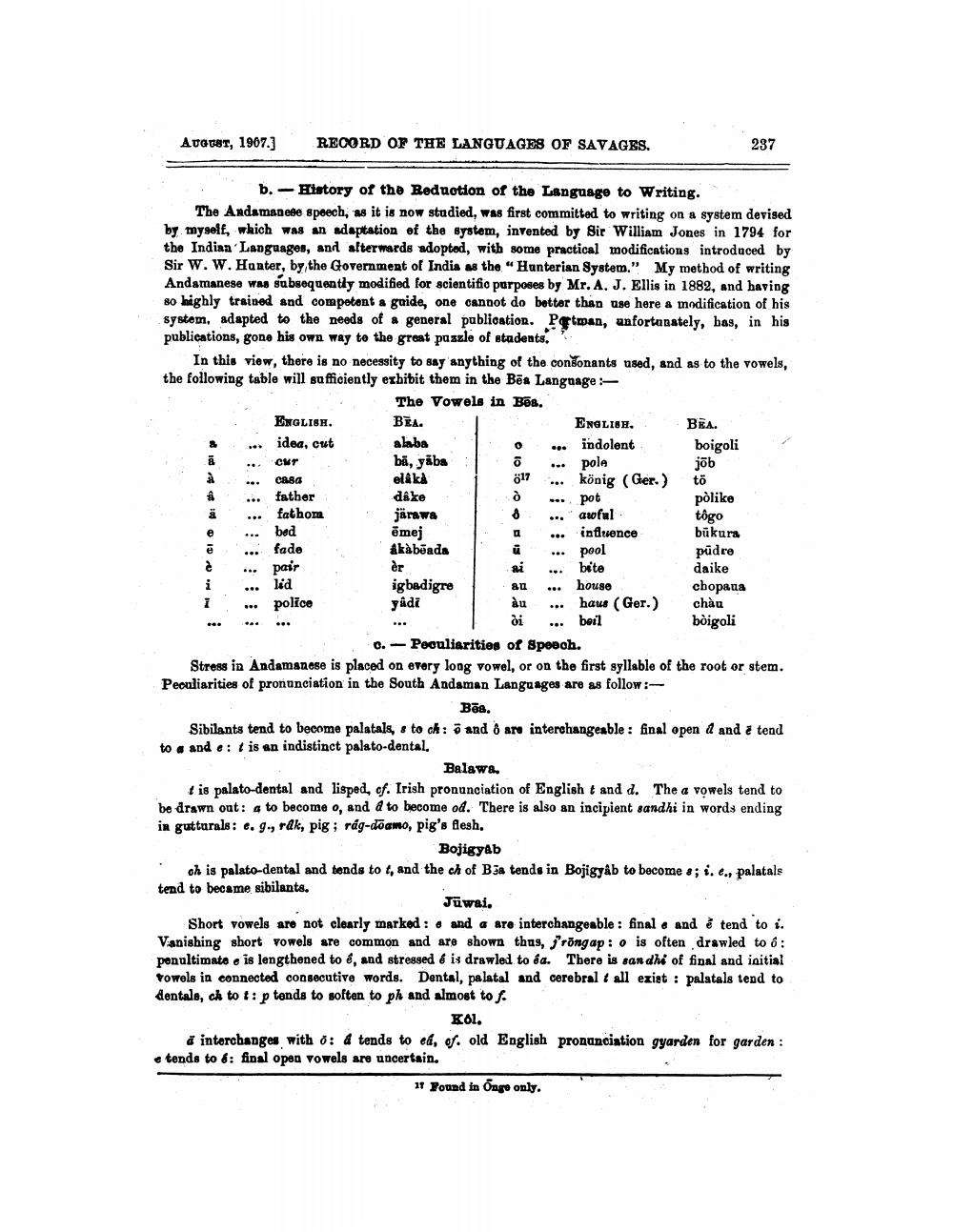________________
August, 1907.)
REOORD OF THE LANGUAGES OF SAVAGES.
237
b. - History of the Reduction of the Language to Writing. The Andamanege speech, as it is now studied, was first committed to writing on a system devised by myself, which was an adaptation of the system, invented by Sir William Jones in 1794 for the Indian Languages, and afterwards adopted, with some practical modifications introduced by Sir W. W. Hunter, by the Government of India as the "Hunterian System.” My method of writing Andamanese was subsequently modified for scientific purposes by Mr. A. J. Ellis in 1882, and having 80 highly trained and competent a guide, one cannot do better than use here a modification of his system, adapted to the needs of a general publication, Portman, unfortunately, bas, in his publications, gone his own way to the great puzzle of stadents.
In this view, there is no necessity to say anything of the conšonants used, and as to the vowels, the following table will sufficiently exhibit them in the Bēs Language :
The Vowels in Bas. ENGLI8H. BEA.
ENGLISH, BEA. idea, cut alaba
indolent
boigoli ... CUT bā, yabal ō ... pole
job casa
elka i ... könig (Ger.) dázet
pot
pòlike fathom järawa
awful
tôgo bed ēmej
influence
būkura Akaboada
pool
pudre pair
ai ... båte
daike lid igbadigre
house
chopaua : ... police
yadi
àu ... haus (Ger.) chào òi ... beil
bòigoli 0.- Peouliarities of Speech. Stress in Andamanose is placed on every long vowel, or on the first syllable of the root or stem. Peculiarities of pronunciation in the South Andaman Languages are as follow:
Bēs. Sibilants tend to become palatals, s to ch: 7 and 8 are interchangeable: final open d and a tend to a and e: t is an indistinct palato-dental.
...
father
fade
er
Balawa.
& is palato-dental and lisped, of. Irish pronunciation of English t and d. The a vowels tend to be drawn out: 4 to become o, and a to become od. There is also an incipient sandhi in words ending in gutturals: e. 9., rak, pig; rág-doamo, pig's flesh.
Bojigyab ch is palato-dental and tends to t, and the ch of Bža tends in Bojigyáb to become s; i. e., palatals tend to became sibilants.
Jūwai. Short vowels are not clearly marked : & and a are interchangeable : finale and ê tend to i. Vanishing short vowels are common and are shown thus, j'rongap: o is often drawled to o: penultimato e is lengthened to é, and stressed 6 is drawled to ea. There is sandhi of final and initial Vowels in connected consecutive words. Dental, palatal and cerebral t all exist : palatals tend to dentale, ch to t: p tends to soften to ph and almost to f.
KOL. a interchanges with 0: & tends to ea, of. Old English Pronunciation gyarden for garden : e tends to 6: final open vowels are uncertain.
11 Found in Onge only.




